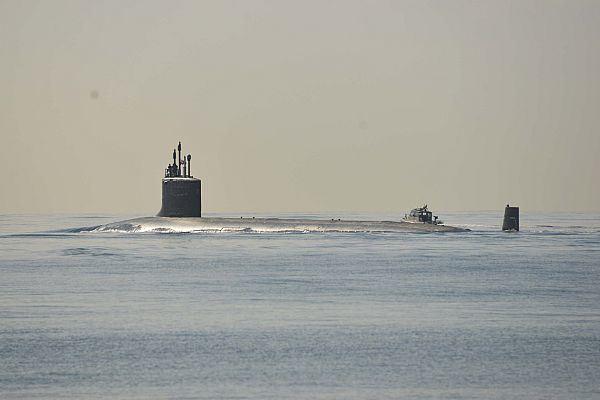The Navy will deploy its first underwater drones from Virginia-class attack submarines for the first time in history later this year, the Navy's director of undersea warfare said Monday.
The deployment will include the use of the Remus 600 Unmanned Underwater Vehicles, or UUVs, performing undersea missions in strategic locations around the globe, Rear Adm. Joseph Tofalo, told Military.com at the Navy League's Sea Air Space annual symposium at National Harbor, Md.
"Now you are talking about a submarine CO who can essentially be in two places at the same time – with a UUV out deployed which can do dull, dirty and dangerous type missions. This allows the submarine to be doing something else at the same time," Tofalo said. "UUVs can help us better meet our combatant command demand signal. Right now, we only meet about two-thirds of our combatant commanders demand signals and having unmanned systems is a huge force multiplier."
The Remus 600 is a 500-pound, 3.25-meter long UUV equipped with dual-frequency side-scanning sonar technology, synthetic aperture sonar, acoustic imaging, video cameras and GPS devices, according to information from its maker, Hyrdoid.
The Remus 600 is similar to the BLUEFIN Robotics UUVs, such as the BLUEFIN 21, that were used to scan the ocean floor in search of the wreckage of the downed Malaysian airliner last year.
The upcoming deployment of the Remus 600 is part of a larger Navy effort to use existing commercial off-the-shelf technology, Tofalo explained.
"We're using commercial off-the-shelf technologies to do real world missions for the combatant commander. The oil and gas industry uses these things for all kinds of functions. The submarine force will be adapting this. The sensors are similar to the sensors that the oil and gas industry might use. They might be surveying where their oil pipes are, whereas we might want to be looking for a mine field," Tofalo said.
The Remus 600s will launch from a 11-meter long module on the Virginia-class submarines called the dry deck shelter which can launch divers and UUVs while submerged.
Related Video
Sonar technology uses acoustic or sound-wave technology to bounce signals off an object and analyze their return to learn the size, shape, distance and dimensions, Tofalo explained.
"It is similar to radar (electromagnetic) except from an acoustic standpoint. Sonar sensors use acoustics to create a picture that a trained operator can use to discern what they are looking at. It has gotten so good that it is almost like looking at a picture," he added.
Alongside efforts to make preparations for the first deployment of commercially available UUVs from the Virginia-class attack submarines, the Navy is also planning at-sea tests this year of a UUV launching technology which uses the boat's torpedo tubes. The at-sea test will examine the technological interface between a UUV and the missile tube as a launcher, Tofalo explained.
The Navy has been working on developing an 85-foot long section of the Virginia-class submarines called the Virginia Payload Modules. This would help submarines launch both missiles and UUVs from the submarine.
"For the large diameter UUV itself, what we want to have is an interface that allows it to come out of that Virginia Payload Module tube. To do that we need an arm that can extend itself with a little platform that can extend itself and go to the vertical," Tofalo said.
At the same time, the Office of Naval Research is preparing to unveil a new autonomous 30-foot UUV prototype called the Large Displacement Unmanned Undersea Vehicle, or LDUUV.
The LDUUV is a prototype which may take a variety of different forms in coming years as the technology evolves, said Bob Freeman, ONR spokesman. The LDUUV is being engineered for greater endurance and energy, he added. It will also be autonomous and able to navigate itself through the undersea domain.
Alongside UUVs, the Navy is also experimenting with launching aerial drones from submarines as well, Tofalo said.
The service is testing the Switchblade, which can launch from a small signal injector tube from the side of the submarine. The Switchblade, built by AeroVironment, is a battery-powered unmanned aerial vehicle that can carry three pounds worth of explosives, Tofalo added.
He added that the Navy is also testing a longer-endurance submarine-launched UAV called XFC, an acronym for experimental fuel cell. XFC, which can be launched from a torpedo tube, can stay in the air for nine to ten hours.
"These are ways that a submarine can extend its horizon. They have been tested and we're continuing to work on making them more definitive programs of record," Tofalo said.
-- Kris Osborn can be reached at kris.osborn@military.com





























